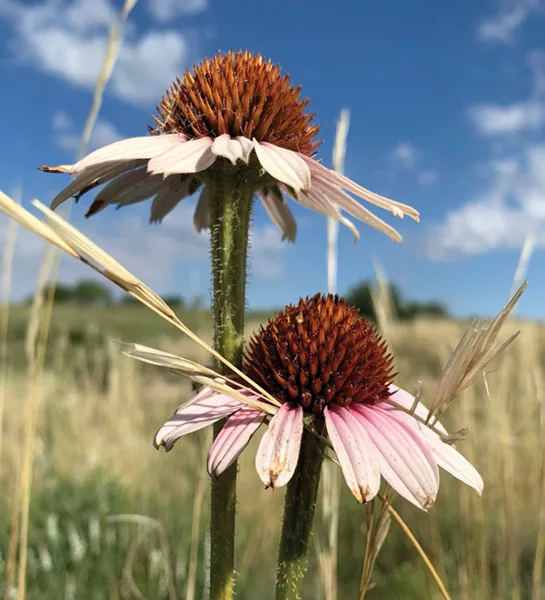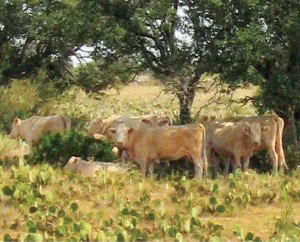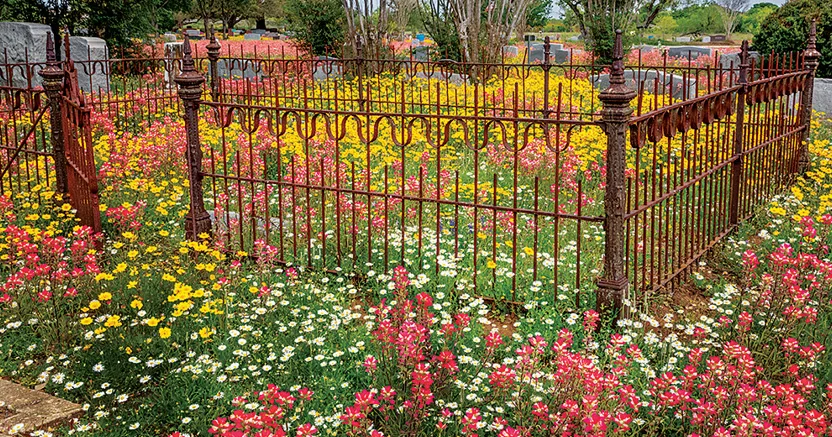
"Native plants give us a sense of where we are in this great land of ours. I want Texas to look like Texas and Vermont to look like Vermont." - Lady Bird Johnson
Texas Ecoregions Thrive with Native Plants
By Lindsey Townsend, Tyler Chapter
Texas really IS like a whole ‘nother country. Its sheer size, variety of terrain, and biological diversity is staggering. The great Lone Star state contains barrier islands and coastal lowlands, large river floodplain forests, rolling plains and plateaus, forested hills, deserts, and a wide variety of aquatic habitats. Texas is blessed with nearly 425 species of butterflies, 634 species of birds, and more than 4,600 species of native plants, according to LandScope America, an online resource for conservation action in the U.S.
Experts agree that native plants play a critical role in preserving this biodiversity in the Texas ecosystem. In fact, they are so crucial to its health that the National Audubon Society has stated that native plants are the ecological basis upon which life depends. “They’re an important food source for local and native insect populations as well as pollinators. Once established, they require less maintenance, less resources, and less water use–and they’re good for the birds and the bees,” says Barry Lipscomb, Director of BRIT Press and Library, Leonhardt Chair of Texas Botany.
“Native plants from nearby habitats such as perennial wildflowers have a better chance of being pollinated by native insects in Texas landscape plantings,” agrees Jason Singhurst, a Botanist/Plant Ecologist with the Nongame and Rare Species Program at the Texas Parks and Wildlife Department.
Native plants have naturally adapted to their specific soil conditions, rainfall cycles, and temperature gradients over time through an intricate process of evolution, which allows them to thrive in their native environments. “I live west of I-35 in Bell County, and I chose plants that are native to the Edwards Plateau, such as Rock Rose (Pavonia lasiopetala), Cedar Sage (Salvia roemeriana), Texas Lantana (Lantana urticoides), Blackfoot Daisy (Melampodium leucanthum), Red Yucca (Hesperaloe parviflora), and Zexmenia (Wedelia acapulcensis var. hispida).
These species grew here before I arrived, and they will continue to grow after my departure,” says Dave Slaughter, Tonkawa chapter member and a graduate of the Texas A&M Master Gardener course. Slaughter has completed advanced training in entomology, vegetable gardening, butterfly gardening, and plant propagation.
“I know if I plant non-natives, I will need to amend the soil, maybe adjust pH levels, and use more water to sustain plant life. Additionally, non-natives will probably require fertilizers and be subject to pests and diseases,” he notes. “I have learned through much trial and error that native plants grow the best and require the least amount of effort. I have learned this lesson in Texas, Colorado, Washington, Virginia, and Pennsylvania; and still today, I continue to re-learn that lesson.”


Local Heroes
From the humid Gulf Coast to the arid landscapes of West Texas, there are many tough, adaptable natives that have evolved to thrive under the Lone Star State’s varied conditions. Whether it’s the searing sun and rocky terrain of the Hill Country or the marshy soils of the Pineywoods, they offer a nearly foolproof knack for blooming whether they’re planted.

“Drummond’s Onion (Allium drummondii), Evening Primrose (Oenothera speciosa), Crow Poison (Nothoscordum bivalve), and Golden Tickseed (Coreopsis tinctoria) are just a few of the Texas native plants that thrive in all ecoregions of Texas,” notes Singhurst.
Here are a few other native plants that thrive in specific regions of Texas, making them excellent choices for sustainable landscaping and conservation efforts.
Chihuahuan Deserts This arid ecoregion covers roughly the same area as the Texas Parks & Wildlife Department’s Trans-Pecos’ vegetative region. Look for Desert Marigold (Baileya multiradiata), Prickly Pear Cactus (Opuntia engelmannii), and Ocotillo (Fouquieria splendens).
The colorful Big Bend Bluebonnet (Lupinus havardii), Soaptree Yucca (Yucca elata), and Harvard’s Century Plant (Agave havardiana) also thrive in this challenging environment.
High Plains
The High Plains region features a unique mix of grasslands and shrub lands. Buffalo Grass (Bouteloua dactyloides), and Blue Grama Grass (Bouteloua gracilis) are well-suited to the area’s climate. Other native plants that thrive in this region include Plains Prickly Pear (Opuntia polyacantha), Golden Prairie Clover (Dalea aurea), and many species of Yucca.
Southwestern Tablelands

Also known as the Southern High Plains, this semi-arid region includes a diverse array of native plants, including Sand Sagebrush (Artemisia filifolia), Western Soapberry (Sapindus saponaria), and Soapweed Yucca (Yucca glauca). Texas Bluebonnet (Lupinus texensis), Blackfoot Daisy (Melampodium leucanthum), and Winecup (Callirhoe involucrata) add a splash of color.
Central Great Plains

The Central Great Plains region is home to many adaptable native plant species, including Prairie Cordgrass (Spartina pectinata), Switchgrass (Panicum virgatum), and Little Bluestem Grass (Schizachyrium scoparium) grasses. Keep an eye out for White Sage (Salvia azurea), Texas Prickly Pear (Opuntia lindheimeri), and Purple Prairie Clover (Dalea purpurea) as well.
Cross Timbers
In the Cross Timbers ecoregion, you’ll find a mix of woodland, grassland, and prairie species. Native plants include Post Oak (Quercus stellata), Blackjack Oak (Quercus marilandica), and Eastern Red Cedar (Juniperus virginiana). Wildflowers such as Indian Paintbrush (Castilleja indivisa), Black-eyed Susans (Rudbeckia hirta), and Illinois bundleflower (Desmanthus illinoensis) also flourish here.
Edwards Plateau

Andrew Awalt
Known for its rocky terrain, the Edwards Plateau region supports a diverse range of native plants. Texas Mountain Laurel (Dermatophyllum secundiflorum), Plateau Live Oak (Quercus fusiformis), and Agarita (Berberis trifoliolata) thrive in the area. Golden Tickseed (Coreopsis tinctoria), Winecup (Callirhoe involucrata), and Drummond’s Phlox (Phlox drummondii) are just a few of the area’s most striking wildflowers.
Southern Texas Plains

This region features a mix of grasslands and shrublands. A few native plants include Honey Mesquite (Prosopis glandulosa), Texas Ebony (Ebenopsis ebano), and Prickly Pear Cactus (Opuntia engelmannii). Colorful wildflowers like Smooth Winecup, (Callirhoe leiocarpa), Blue Mistflower (Conoclinium coelestinum), and Texas Lantana (Lantana urticoides) enhance the landscape.
Texas Blackland Prairies

The Texas Blackland Prairie region hosts a variety of native grasses, including Little Bluestem (Schizachyrium scoparium), Big Bluestem (Andropogon gerardii), Yellow Indian Grass (Sorghastrum nutans), and Switchgrass (Panicum virgatum). Wildflowers such as Purple Coneflower (Echinacea angustifolia), Purple Paintbrush (Castilleja purpurea), and American Basket Flower (Centaurea americana) add color to the prairie.
East Central Texas Plains

Some native trees and plants commonly found in East Texas include Post Oak (Quercus stellata), Eastern Redbud (Cercis canadensis), American Beautyberry (Callicarpa americana) and Yaupon Holly (Ilex vomitoria). A wide variety of wildflowers can also be found here, including Indian Paintbrush (Castilleja indivisa), Purple Coneflower (Echinacea sanguinea), and coreopsis (Coreopsis spp.).
Gulf Coast Prairies and Marshes
The coastal areas feature plants that tolerate wet conditions well, including Gulf Cordgrass (Spartina spartinae), Gulf Bluestem (Andropogon glomeratus), and Seashore Paspalum (Paspalum vaginatum).
Saltmarsh Morning Glory (Ipomoea sagittata), Powderpuff (Mimosa strigillosa), Partridge Pea (Chamaecrista fasciculata), and Gulf Coast Penstemon (Penstemon tenuis) are a few wildflowers.
Western Gulf Coastal Plain

This region showcases a wide range of plant species that have adapted to the coastal plain’s sandy soils, salt spray, and humid environment. Look for Live Oak (Quercus virginiana), Eastern Red Cedar (Juniperus virginiana), Wax Myrtle (Morella cerifera), Saltmarsh Cordgrass (Spartina alterniflora), and Gulf Coast Muhly (Muhlenbergia capillaris). Native flowers such as Gulf Coast Penstemon (Penstemon tenuis), Beach Evening Primrose (Oenothera drummondii), and Coral Bean (Erythrina herbacea) contribute to the region’s diversity.
Want a list of Texas native plants that perform well during droughts for next summer? Work well in dry shade? Or attract hummingbirds? The Society’s website offers a wealth of resources, guides, and databases related to native plant gardening. For profiles and images of native plants in your area or to find more information about the ecoregion where you live, visit npsot.org.
References
- Griffith, Bryce, Omernick & Rodgers (2007), Ecoregions of Texas
- Texas Parks and Wildlife Department
Did you like this article? It’s from our Fall 2023 Texas Native Plants magazine. Read more here



